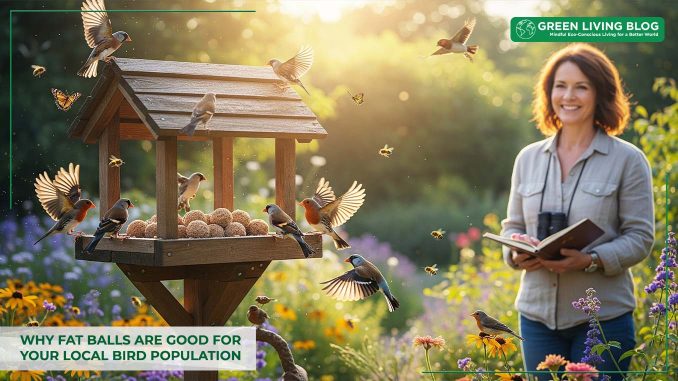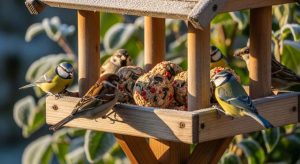
If you’re looking for ways you can help support your garden birds, there’s one small addition that can make a big difference: fat balls.
These tasty, energy-packed snacks are a firm favourite for many bird species – and for good reason!
Fat balls are an excellent source of calories and nutrients for wild birds, giving them the energy they need to stay active and healthy (especially during the cold winter months, when natural food sources are hard to come by).
What Are Fat Balls?
Fat balls, also known as suet balls, are a type of bird food typically made from suet (animal fat), seeds and other ingredients like mealworms, berries, insects and nuts. They are shaped into balls and can be placed in feeders, on bird tables, or even just on the ground.
Why Are Fat Balls Good for Birds?

1. They’re packed with energy
Birds require a high-calorie diet to maintain their body heat and stay active, particularly in winter. Fat balls provide just that as they are packed with healthy fats and oils to give birds the fuel and energy they need to continue foraging and flying all through the year.
2. They’re rich in nutrients
Good-quality fat balls tend to contain seeds, insects and grains, providing a balanced mix of the proteins, fat and nutrients that are so vital to any bird’s health. Low-quality fat balls, however, tend to be made using cheap fillers like chalk and wheat – ingredients that your garden birds are sure to turn their beaks up at! For this reason, you should always aim to get the very best fat balls that contain the nutrients your garden birds need for a healthy, balanced diet.
3. They’re easy to eat and digest
The soft texture of suet makes fat balls nice and easy to peck at. They’re beloved by a wide range of different bird species, particularly little birds like tits, sparrows and finches that have small and delicate beaks. Fat balls also have a high fat content, making them easy for birds to quickly digest, metabolise and convert into usable energy.
4. They help to bolster wild bird numbers
The high energy content of fat balls comes in particularly useful during the breeding season, when adult birds spend huge amounts of energy mating, incubating eggs, feeding their chicks and building nests. Yummy fat balls provide a quick and easy calorie boost to help wild birds meet these increased energy demands.
5. They’re versatile
Fat balls are an exceptionally versatile snack for your feathered friends, not only because they are loved by a wide range of wild birds, but also because they can be offered up in a variety of different ways. You can get specialised fat ball or suet feeders to add to your feeding station, or you can simply leave the fat balls on a bird table or ground tray in your eco-friendly garden – either way, your garden birds are sure to gobble them up in no time!
Tips for Feeding Fat Balls to Your Garden Birds

- Fat balls can become spoiled and harmful to wild birds if left out in warm weather for extended periods of time, so it is recommended that you clear away any uneaten food and replace it with fresh suet once a week.
- Always put your fat balls out in a cool, sheltered location during the warmer months. This will help to shield that succulent suet from the elements, plus it ensures that your feathered friends will have an easy escape route if a predator decides to visit.
- If the weather is really hot, you can even store your fat balls in the freezer and put them out frozen for a little extra longevity!
- Never offer fat balls to birds in plastic or mesh nets. Wild birds can become tangled and seriously injured in this type of netting – plus, the mesh itself can contribute to environmental pollution if it’s not biodegradable.
Fat balls are more than just a tasty treat – they are a lifeline for your local bird population. Whether you’re a wildlife enthusiast or an avid birdwatcher, giving your garden birds some tasty fat balls to munch on is a small act that can make a big impact!
![]()
Author Profile
- Passionate content creator, contributor, freelance writer and content marketing allrounder.
Latest entries
 Green Home GuidesDecember 10, 2025How Windows and Doors Can Cut Your Energy Bills and Help the Planet
Green Home GuidesDecember 10, 2025How Windows and Doors Can Cut Your Energy Bills and Help the Planet EnvironmentNovember 18, 2025What Are Ecological Surveys? Definition, Purpose, and Process
EnvironmentNovember 18, 2025What Are Ecological Surveys? Definition, Purpose, and Process BusinessOctober 23, 2025Legionnaires’ Disease: 3 Essential Actions to Control Risk While Supporting Sustainability
BusinessOctober 23, 2025Legionnaires’ Disease: 3 Essential Actions to Control Risk While Supporting Sustainability EnvironmentJuly 21, 2025Why Fat Balls Are Good For Your Local Bird Population
EnvironmentJuly 21, 2025Why Fat Balls Are Good For Your Local Bird Population






Leave a Reply
You must be logged in to post a comment.